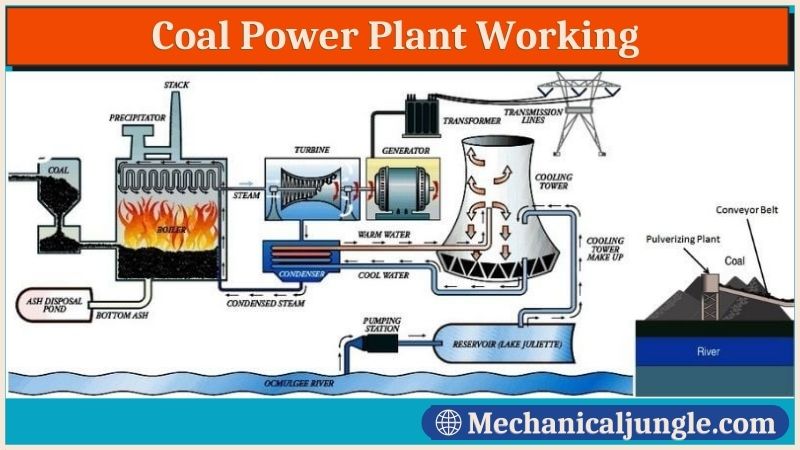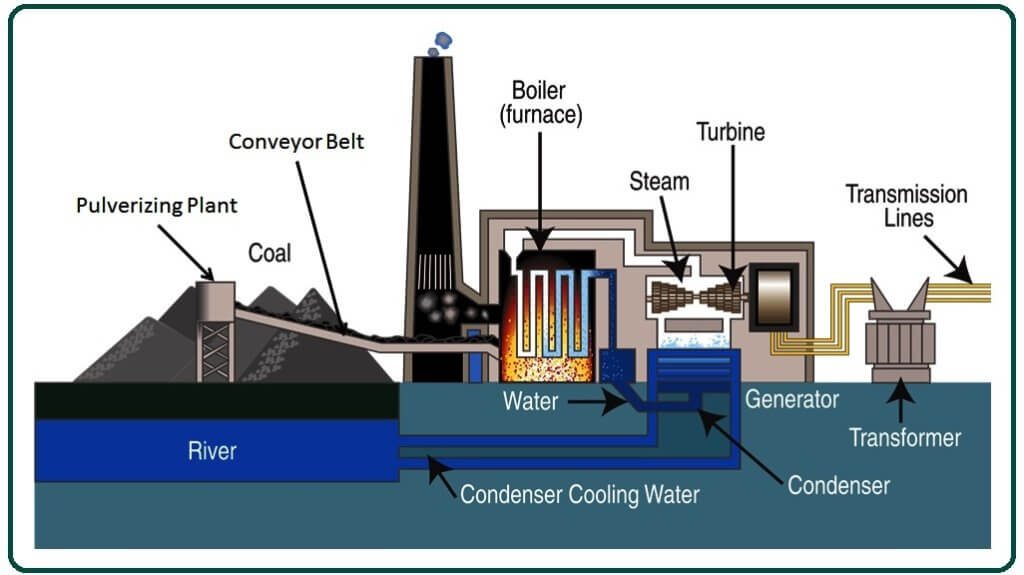Important Point
Coal-Fired Power Plant:
Coal-based power plants are a type of power plant that uses coal combustion to generate electricity. Countries like South Africa use coal for 94% of their electricity, and China and India use 70-75% of coal for their electricity needs; however, the amount of coal in China dwarfs that in other countries. Their use provides about 40% of the world’s electricity, and they are mainly used in developing countries.
The use of coal provides electricity to those who did not have it before, which helps to increase the quality of life & reduce poverty in those areas; however, it produces a large number of various pollutants that are used in the air. Reduces quality and contributes to climate change.
Also, Read: What Is a Hydro Power Plant? | Working of Hydropower Plant | Types of Hydropower Plants
Working of Coal Power Plant:
The work of the coal power plant begins with the arrival of coal from the coal mines via trains. This coal is then transported to the power plant to be converted into a powder form. The main reason behind converting it into powders is to increase the efficiency of burning by increasing its contact area exposed to fire in the burner as compared to solid coal.
This coal dust is fed through a blower in the boiler; The thermal energy released from this fuel is used to boil water up to 1000 degrees Fahrenheit, thus converting it into high-pressure steam that is transferred to turbines. This energy is used to generate electricity through a generator.
Due to such high RPM, the voltage output of the generator is approximately 24000 volts, which can be transferred to about 40,000 volts via transmission cables. The steam is expanded one by one in 3 consecutive turbines to take full advantage of the pressure energy.
These turbines actually turn at high RPMs, which convert pressure energy into mechanical energy. The temperature of thises water is kept under a safe range so that it does not harm the aquatic lives of the water body. Furthermore, to extract heat from this steam, the cold water of the reservoir or river is pumped into the condenser, and after heat exchange, it is pumped back into the water body.
Main Components of Coal Power Plant:
#1. Conveyor Belt
Coals from the coal storage area are transported to the plant through a large conveyor belt. The load-carrying capacity of this belt is very high because very large quantities of coal are required every day.
#2. Pulverizing Plant
The coal transported by conveyor cannot be used in the same way as previously converted to powder, also known as inflated coal. It is designed to rotate in a cylindrical tank at high speed with several spherical steel balls and is thus converted into powder. The pulverizing plant also has un-pulse-enhanced coal storage and can store up to 30 hours of coal reserves.
#3. Boiler
The inflated coal is fed into the boiler through large fans flowing hot air. The boiler consists of several water-filled taps, and these tubes boil water up to 1000 degrees Fahrenheit and the flames in the boiler go up to 50 meters.
#4. Turbine
High-pressure steam at a thousand degrees Fahrenheit from the boiler and 3500 pounds per square inch of pressure is then fed to the steam turbine, which converts its pressurized energy into mechanical energy.
#5. Generator
A generator uses the mechanical energy generated by the turbines to generate electricity at significantly higher voltages.
#6. Condenser
The steam leaving the turbines is condensed into a condenser, which is pumped back into the boiler. Coldwater from a water source (river) or expansion process is used to cool steam into water.
Also, Read: Top 10 Mechanical Companies in USA 2021
Pollution Control of Coal Power Plant:
The biggest drawback of a coal power plant is its fly ash content and the release of sulfur dioxide during coal burning. All coal-fired power plants are always under the scrutiny of agencies involved in environmental pollution. Also, there is always pressure on developing countries to keep their pollution levels under control.
Smoke-blowing ash is removed by a mechanical process, while sulfur dioxide is removed by reactions with lime, thus converting it into gypsums, which can be used in agricultural fields & many. There are other applications. The entire process takes place in a scrubber that is located between the boiler and the chimney.
A mixture of lime and water is sprayed on the smoke emanating from the boiler, reducing the amount of ash blowing in the air by one percent and reducing the amount of sulfur dioxide by 93%. Preplated fly ash can also be used in making concrete & other anti-skid road materials. In some coal power plants, nitrogen dioxides are also removed from the smoke. It is passed into cars through a catalytic converter to remove nitrogen dioxide.
The catalytic converter consists of layers of ammonia. When nitrogen dioxide is passed through these layers, it reacts with ammonia and is converted to nitrogen and water. Nitrogen is released into the atmosphere because the amount of nitrogen in the air we breathe is 71%, so it is quite safe.
Also, Read: Top 10 Mechanical Companies in India 2021
Advantages of Coal Power Plant:
- It is one of the most reliable sources of energy, considering other power plants that depend on weather conditions, such as wind power plants and hydropower plants.
- It is the cheapest source of energy available to produce electricity for the good economic development of the country.
- Its end products, such as gypsum and precipitated ash, can be used in many applications.
- It is available in plenty, so there will be no interruptions in production in the coming years.
- Keeping India in mind, this energy generation tool employs a large part of the population.
Also, Read: What Is Cooling Towers? | Working of Cooling Towers | Types of Cooling Towers
Disadvantages of Coal Power Plant:
- It pollutes the environment by releasing harmful gas such as sulfur dioxide and nitrogen dioxide.
- Coal mines leave people with their own homes, as it is not safe to live in an area with mines.
- These gases have a harmful greenhouse effect, which is the most dangerous thing given the current environmental conditions.
- The carbon material released from the chimney in the form of fly ash pollutes the environment in the most adverse way.
Application of Coal Power Plant:
- The coal power plant produces a large amount of electricity for our homes, hospital, industries, schools, etc.
- Coal has been used as a fuel source for locomotives for years.
Frequently Asked Questions (FAQ)
Coal-Fired Power Plant
A coal-fired power plant, also known as a coal-fired power plant, is a plant that burns heat to make steam to produce electricity. These plants, shown in Figure 1, provide approximately 40% of the world’s electricity.
Coal Power Plant
A coal-fired power station or coal power plant is a thermal power station that burns coal to generate electricity. Worldwide there are about 8,500 coal-fired power stations totaling over 2,000 gigawatts of capacity.
How Does a Coal Power Plant Work?
Coal-fired plants produce electricity by burning coal in a boiler to produce steam. The steam produced, under tremendous pressure, flows into a turbine, which spins a generator to create electricity. The steam is then cooled, condensed back into the water, and returned to the boiler to start the process over.
Advantages of Coal Power Plant
- Huge Global Reserves.
- Not an Intermittent Energy Source.
- Reliable Fuel.
- Inexpensive Energy Source.
- Independent of the Weather.
- Plenty of Applications.
- Compatible With Other Energy Sources.
- Creates Jobs.
Disadvantages of Coal Power Plant
Air pollution from coal-fired power plants is linked with asthma, cancer, heart and lung ailments, neurological problems, acid rain, global warming, and other severe environmental and public health impacts.
Like this post? Share it with your friends!
Suggested Read –
- Solar Panel Working
- What Is a Flame in Gas Welding? | Types of Flames in Gas Welding
- Parts and Functions of Grinding Machine | Grinding Machine | Grinding Machine Types
- Parts of Benson Boiler | Working Principle of Benson Boiler | Construction of Benson Boiler
- Working of Locomotive Boiler | Parts of Locomotive Boiler | Advantages of Locomotive Boiler | Disadvantages of Locomotive Boiler
- Turbine Function | Turbine Function of Thermal Power Plant | What Is Steam Turbine Function | Working Principle of Steam Turbine Function


